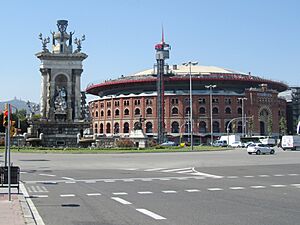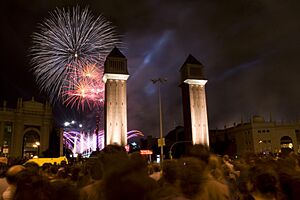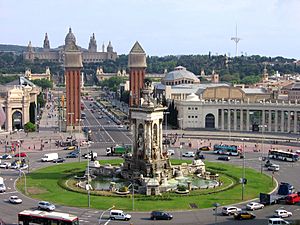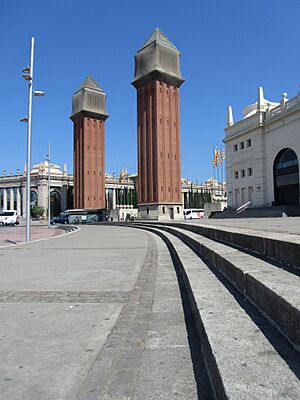Plaça d'Espanya, Barcelona facts for kids


Plaça d'Espanya (which means Place of Spain in English) is one of Barcelona's most important and biggest squares. It was built for a special event called the 1929 Barcelona International Exposition. This big fair happened at the foot of Montjuïc hill, in the Sants-Montjuïc area of the city.
Contents
Cool Features of the Square
Plaça d'Espanya is a very busy spot where several major roads meet. These include Gran Via de les Corts Catalanes, Avinguda del Paral·lel, Carrer de la Creu Coberta, and Carrer de Tarragona. From the square, you can also walk up Avinguda de la Reina Maria Cristina to reach the Palau Nacional. This grand building is home to one of Catalonia's best museums, the Museu Nacional d'Art de Catalunya (MNAC).
The square was designed by Josep Amargós. The beautiful fountain in the middle was created by Josep Maria Jujol, who also worked with the famous architect Antoni Gaudí. The statues around the fountain were made by Miquel Blay. The buildings around the square were designed by Nicolau Maria Rubió i Tudurí.
Here are some cool things you can find around the square:
- Venetian Towers: These two tall towers, 47 meters (154 feet) high, stand at the entrance to Avinguda de la Reina Maria Cristina. This avenue is often used for big trade fairs and events.
- Fira de Barcelona: This is a major trade fair institution in Barcelona, with some of its venues located near the square.
- Parc de Joan Miró: This park used to be called Parc de l'Escorxador (Abattoir Park). Now, it's named after the famous Catalan painter Joan Miró. You can see his huge 22-meter-tall statue called Dona i Ocell (Woman and Bird) in one part of the park.
- Arenas de Barcelona: This building was once a bullring, built in 1900 in a unique Moorish Revival style. Today, it has been transformed into a modern shopping center, full of shops and restaurants.
A Look at History
The area where Plaça d'Espanya now stands used to be a place for public hangings a long time ago. This changed in 1715 when the Ciutadella fortress was built, and the gallows were moved there.
The design for Plaça d'Espanya was created in 1915. The square itself was built in 1929. This was done so it would be ready to host the big 1929 Universal Exposition. Since then, the square has been a busy and important public space for everyone to enjoy.
Getting Around: Transport Hub
Plaça d'Espanya is also a very important place for public transport. It connects many different parts of the Metropolitan Area of Barcelona.
Metro Lines
You can catch several metro lines at the Espanya metro station:
Bus Routes
Many bus lines stop at Plaça d'Espanya, connecting it to various neighborhoods:
- Line 7: Diagonal Mar - Maria Cristina
- Line 9: Pl. Catalunya - Pg. Zona Franca
- Line 13: Mercat de St. Antoni - Can Clos
- Line 23: Pl. Espanya - Parc Logístic
- Line 27: Pl. Espanya - Roquetes
- Line 30: Pl. Espanya - Sarrià
- Line 34: Sarrià - Virrei Amat
- Line 36: Paral·lel - Can Drago
- Line 37: Hospital Cínic - Zona Franca
- Line 43: Les Corts - Sant Adrià
- Line 46: Pl. Espanya - Aeroport
- Line 50: Montjuïc - Trinitat Nova
- Line 56: Collblanc - Besòs / Verneda
- Line 57: Barcelona (Pg. Marítim) - Cornellà (Estació busos)
- Line 61: Poble Sec - Parc de Montjuïc
- Line 68: Poble Sec - Parc de Montjuïc
- Line 79: Pl. Espanya - Av. Carrilet (M)
- Line 80: Barcelona (Pl. Espanya) - Gavà (Av. Joan Carles II)
- Line 81: Barcelona (Pl. Espanya) - Gavà (Av. Joan Carles II)
- Line 91: Rambles - Bordeta
- Line 153: Barcelona - Cornellà
- Line 157: Pg. Marítm - Sant Joan Despí
- Line 193: Pl. Espanya - C. Montjuïc
Night Bus Routes
Even at night, buses run through Plaça d'Espanya:
- Line N0: Pl. Portal de la Pau - Pl. Portal de la Pau (circular)
- Line N1: Zona Franca (Mercabarna) - Pl. Catalunya - Roquetes (Aiguablava)
- Line N2: Hospitalet (Av. Carrilet) - Badalona (Via Augusta)
- Line N14: Barcelona (Rda. Universitat) - Castelldefels (Centre Vila)
- Line N15: Barcelona (Pl. Portal de la Pau) - Sant Joan Despí (Rbla. Josep Maria Jujol)
- Line N16: Barcelona (Rda. Universitat) - Castelldefels (Bellamar)
- Line N17: Pl. Catalunya - Aeroport
Train Services
You can also catch trains from Plaça d'Espanya, operated by Ferrocarrils de la Generalitat de Catalunya (FGC).
FGC Train Lines
These lines are part of the Metro del Baix Llobregat network:
- R5/R50: Manresa-Baixador
- R6/R60: Igualada
- S3: Can Ros
- S4: Olesa de Montserrat
- S8: Martorell-Enllaç
- S9: Quatre Camins
- L8: Molí Nou
See also
In Spanish: Plaza de España (Barcelona) para niños
- Urban planning of Barcelona



